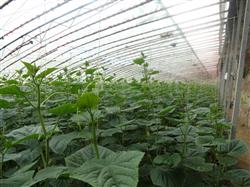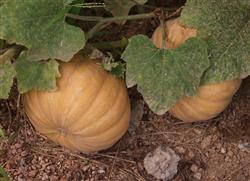Intercropping cultivation techniques of cauliflower and pumpkin in spring

Pumpkin is a vegetable with high nutritional value, which is welcomed by people because of its dual functions of food and health. There is a large land surplus space in the early stage of pumpkin cultivation, resulting in a waste of land and light and heat resources. We use cauliflower and pumpkin intercropping cultivation, which has the advantages of low investment, simple method and high economic benefits. it is widely welcomed by farmers in suburban vegetable areas. First, a strap. Every 3.3 meters is a cuff, which is divided into 3 beds on average, each with a width of 1.1 meters. Ditch before planting, ditch width 45 cm, depth 15 cm, sufficient farm fertilizer, N, P, K compound fertilizer 25-30 kg per mu. Plant 2 rows of cauliflower, 2 rows per row, leave 1 row and then plant 1 row of pumpkins. All are covered with a small arch shed. Second, variety selection and seedling raising. Cauliflower belongs to out-of-season cultivation in spring, and most varieties show early ball, small ball, fuzz and fast ball. On the other hand, Huayu cauliflower showed that the ball was white, compact and commercial in 80 days. Sowing and raising seedlings in the sunny border in mid-December, first wet the seedbed, and then evenly sow the seeds, sowing 6 square meters for every 10 grams of seeds and covering 0.5 cm of fine soil. In the evening, the greenhouse film of the sunny border was covered with grass to keep warm, and in the later stage, we should pay attention to cooling and dispersing dampness in order to cultivate strong seedlings. Pumpkin can choose Changmian No. 2, which is a first-generation hybrid variety with rapid growth and resistance to downy mildew, virus and powdery mildew. To raise seedlings in early spring and early February, soak the seeds in 30 ℃ warm water for 4-5 hours, remove them, spread them on a wet towel, roll them up and put them in an incubator, set the temperature to 32 ℃ for germination. Generally, the shell can be broken and sprouted after 24-26 hours. Generally, farmers often use soil incubator to promote germination, the method is: roll up the seeds with a wet towel, put them into a cardboard box with a length, width and height of 40 cm × 30 cm × 40 cm, and then suspend a 25W light bulb, insert a thermometer at the same time, put a cotton pad on the outside to keep warm, and control the temperature at about 32 ℃ to accelerate germination. Pick out the germinated seeds and put them in a prepared nutrition bowl, 1 grain per bowl, cover with nutrient soil 1-1.5cm, and place them in a greenhouse or sunny bed with a temperature of more than 25 ℃ in the daytime and no less than 5 ℃ at night. The unsprouted ones continue to sprout. Be careful to prevent rats from picking food. After emergence, the nutrition bowl should be sprinkled with water in time, and pay attention to ventilation and cooling, in order to cultivate strong seedlings. Second, planting and management. The planting time of cauliflower in spring is generally around February 25, the seedling age is about 70 days, and there are 4-5 true leaves. Before planting, the seedling bed should be sprayed with antimicrobial agents to control seedling rot. 50% chlorothalonil or metalaxyl can be selected. Large row 65 cm, small row 45 cm, plant spacing 45 cm, 2690 plants per mu (effective area), 2 rows per arch, covered with arch shed. The light is sufficient in March, so the temperature in the arch shed should be kept under 28 ℃ at any time. Cauliflower growth to the small basin mouth to remove the mulch, can be carried out in the second half of the afternoon or on a cloudy day. Cauliflower needs a large amount of fertilizer, generally topdressing 2-3 times after planting, can be flushed with human feces and urine or 20 kg urea per mu. The main pests are Pieris rapae and Plutella xylostella, which can be controlled by biological pesticides such as diflubenzuron and acyclovir to produce pollution-free cauliflower. Pumpkin seedling period of about 35 days, as long as 4-5 leaves can be planted, around March 10. The plant spacing is 53 cm, single row, planting 380 plants per mu, and then covered in a small arch shed. When most of the melon seedlings grow against the small arch shed, the arch boron can be removed. Press the vine 2-3 times and get rid of the branches. after the first female flower blossoms, artificial pollination should be carried out at 7-9 am. The method is to gently wipe the pollen-covered stamens on the female flower stigma. Each male flower can give 4-6 female flowers. Because it is a generation of hybrids, the sitting melons are neat and consistent. After the first melon is formed, it retains the branches, so that the main stem and branches all sit on the melon. There is no need for artificial pollination. Pumpkin is vulnerable to melon aphid at seedling stage, which can be controlled by 10% imidacloprid or Averfenac. The occurrence of other pests is less, and it is easy to produce pollution-free vegetables. For each harvest of melon, fertilizer should be applied once, and human dung or N, P, K compound fertilizer can be applied. Fourth, harvest and benefit. The harvest time of cauliflower is around May 1. Fold leaves and cover the bouquet 5 days before harvest to make the bouquet white and easy to sell. The suitable time for harvest is when the base of the bouquet is slightly raised and the outer leaves of the plant are obviously opened. The single ball mass is 1-1.5kg, and the benefit per mu is 1500-1800 yuan according to the intercropping area. Cauliflower is harvested many times. Remove the stubble in time for each harvest to make room for the pumpkin until the harvest is finished. It is more economical to harvest tender pumpkins on the market, and you can also harvest some old melons at the same time. When the skin of the young melon changes from bright green to dark green, it is the appropriate time for harvest, generally around May 20, which can be 35 days earlier than that of open field cultivation. Single melon quality 2-2.5 kg, stir-fry delicious, better than zucchini, very popular in the market. When the first melon grows to about 1 kilogram, it begins to sit on the second melon. Together with branched melons, each plant can bear 3-5 melons in full bloom, and the harvest period generally lasts until early November. The yield per mu can reach 5000-6000 kg, and the benefit is 3000-3500 yuan.
- Prev

How to make a pumpkin in spring
Spring open field cultivation techniques 1, sowing and seedling: the pumpkin varieties introduced above belong to the western pumpkin type, spring cultivation is suitable for early sowing, sowing date can be calculated according to the planting period. Such as Jianghuai, can be planted in late April, with seedling age of 30 days, should be planted in late March. If you want to go to a certain place...
- Next

Cultivation techniques of Pumpkin in greenhouse in Spring
First, the variety chooses Beijing green chestnut and Beijing red chestnut pumpkin. 2. The suitable sowing time for pumpkin cultivation in spring greenhouse is generally mid-February. 1. Before raising seedlings, the temperature is relatively low when sowing in the first and middle of February, so the electric hotbed must be used to raise seedlings. (1) the manufacture of electric hotbed: choose to transmit light.
Related
- Where is it suitable to grow horseradish in China? it is expected to see the middle altitude horseradish in Alishan.
- How to prevent tomato virus disease reasonably? (Control methods included)
- Many people like to plant towel gourd on the balcony. What are the main points of this method and management?
- What crops can chili peppers be mixed with?
- Fertilization techniques and matters needing attention in Tomato
- What are the grafting techniques for peach seedlings in spring?
- Harm and control methods of root swelling disease of Chinese cabbage
- What are the pests of sweet potatoes? How to prevent and cure it?
- Symptoms, causes and Control methods of navel Rot in Tomato
- The cause of "Cucumber rotten bibcock" in Farmers' planting Cucumber and its Control Plan

